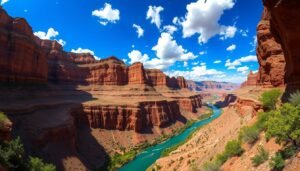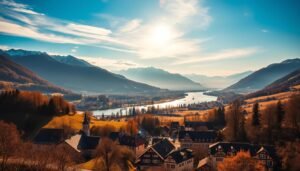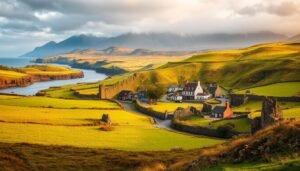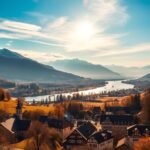Surprising fact: I start most visits aware that this former imperial capital holds roughly 2,000 temples and shrines and 17 UNESCO World Heritage Sites, a scale that reshapes any plan.
I set the scene for the city as a timeless mix of lantern-lit streets, serene temples, and lively food markets like Nishiki. I build my trip so I can savor each place slowly and without stress.
I prefer early mornings and late nights for quiet views at Fushimi Inari and Kiyomizu-dera, then a relaxed midday break for tea or market snacks. I base myself in Southern Higashiyama/Gion to reach sunrise spots on foot and hop trains when I need speed.
My guide is a practical list that says when I go, how long I stay, and the best way to get around. I call out tickets and free highlights, and I time bamboo moments at Arashiyama for the calmest light.
Key Takeaways
- Plan early starts and late walks for quieter photos and reflection.
- Base yourself near Southern Higashiyama/Gion for easy access.
- Mix paid sites with free highlights to balance time and budget.
- Save bamboo moments for sunrise or quieter garden alternatives.
- Use trains, trams, and short walks to make the most of limited days.
How I Plan My Time in Kyoto Right Now: Beating Crowds and Soaking Up the City
![]()
I plan my hours around light and quiet. I chase sunrise lanes and late-night lantern glow so each trip feels calm and personal. Early starts let me see a shrine before crowds gather and give a soft, empty frame for photos.
When I go
I aim for sunrise at major spots: Fushimi Inari around 6 am or after 8 pm, and Kiyomizu-dera at opening. Kinkaku-ji and Ginkaku-ji work well at opening or late afternoon, and Nishiki Market fills up by mid-morning.
Where I stay
I book a room in Southern Higashiyama/Gion. This lets me slip out to Kiyomizu-dera at 6 am and walk quiet lanes before the first buses arrive.
My crowd-beating game plan
- I front-load the morning and save a night walk for riverfront alleys.
- I cluster each day by area so transit feels light and I relax more between stops.
- I keep a short backup list of nearby subtemples if an entrance backs up.
Tip: I favor weekdays for headline sites and leave flex time for weather. This simple guide keeps people and tourists from shaping my whole day.
things to do in kyoto japan: My Can’t-Miss Highlights at a Glance
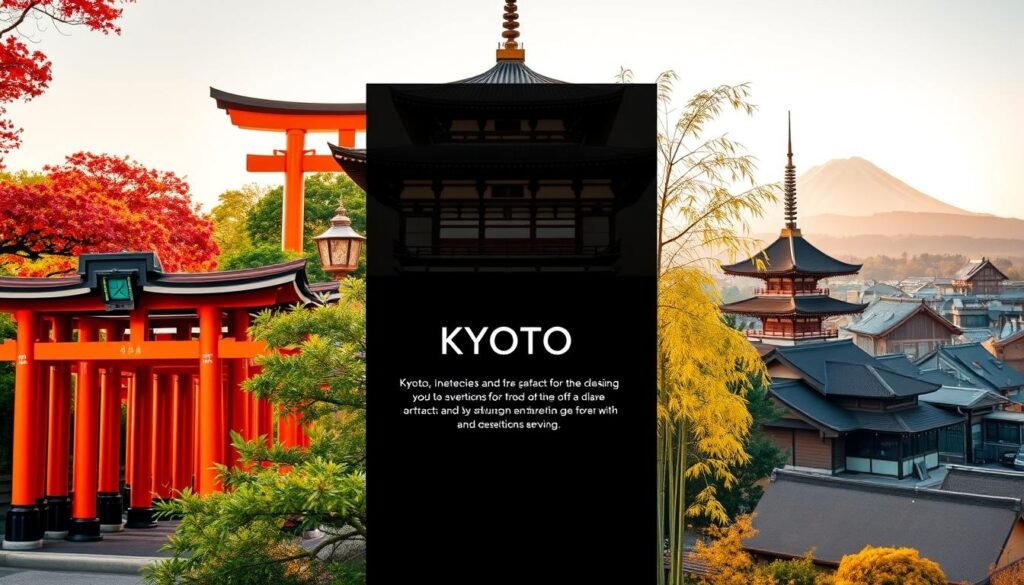
I zero in on a compact set of favorites that fit naturally into a relaxed two- or three-day rhythm. Below is a quick guide to the headline attractions I return to, with practical timing and fees so you can build a smooth plan.
Top temples and shrines for first-time visitors
Fushimi Inari — open 24 hours, free; best at dawn or late evening for quiet walks through vermilion tunnels.
Kiyomizu-dera — 6 am–6 pm, 400 yen; go early for the view from the hillside platform.
Foodie stops, markets, and tea ceremony moments
Nishiki Market pairs perfectly with a lunch break and quick sampling of street snacks and cookware shops.
Tea — book a one-hour ceremony in Gion for a compact cultural experience without losing half a day.
| Place | Hours / Fee | Best time |
|---|---|---|
| Fushimi Inari | 24 hours / Free | Dawn or late evening |
| Kiyomizu-dera | 6 am–6 pm / 400 yen | Opening hour |
| Ginkaku-ji / Kinkaku-ji | G: 8:30–17:00 / 500 yen K: 9:00–17:00 / 500 yen |
Morning or late afternoon |
| Tenryu-ji (Arashiyama) | Garden hours vary / admission applies | Half-day west excursion |
My tip: pick 1–2 big sights per day, add a market or tea break, and tuck a quiet temple or garden into the afternoon for balance.things-to-do-in-portland
Fushimi Inari Shrine: Hiking Under Vermilion Torii From Dawn to Night
![]()
I climb the vermilion corridor at first light and feel the city fade behind each gate. The site is open 24 hours and free, which makes early starts and late returns easy. I plan my time around soft light and quiet paths.
My favorite loop, viewpoints, and how long I spend
I usually take the full loop, about 5 km (3.1 miles). I budget 2–3 hours when I pause at side shrines and the Yotsutsuji viewpoint.
The Yotsutsuji spot is where many end their climb. I often push past it; the trail gets far quieter beyond the main loop.things-to-do-in-atlantic-city
Exact times I go and what it’s like at night
I avoid large tourist groups by arriving around 6–7 am or after 8 pm. Both windows feel magical; at night lantern light and insects create a different mood. Wildlife can appear off the trail, so I keep a small light and water with me.
- Access: Keihan to Fushimi Inari Station or JR Nara Line to Inari Station.
- Tip: skip the lower bottleneck early and circle back later for photos when the entrance calms.
- Respect: this is an active shrine—watch rituals and give space to worshippers.
| Feature | Detail | Best time |
|---|---|---|
| Hours / Fee | Open 24 hours / Free | Dawn (~6 am) or after 8 pm |
| Loop | ~5 km / 1.5–3 hours | Plan 2–3 hours if pausing |
| Access | Keihan: Fushimi Inari Station; JR: Inari Station | Short train ride from central areas |
Kiyomizu-dera: Iconic Views, “Pure Water,” and Serene Early Mornings
![]()
I arrive at opening and step onto a wooden terrace that has held visitors since 778. The main hall is built without nails, and its carpentry reads like a quiet marvel against the hillside.
What I see first: the nail-less main hall, pagoda, and hillside paths
I head straight to the main hall terrace for those famous views and to admire the joinery that holds the structure above the slope.things-to-do-with-kids
I weave down to the pagoda for a different angle, then dip toward the Otowa Waterfall. I choose one stream with intention—longevity, success, or love—and sip quietly.
Night illuminations vs. sunrise: how the experience changes
I visit at 6 am when the gate opens and enjoy a calm hour before tour groups arrive. Sunrise softens rooftops and makes wooden beams glow.
Illuminations in spring and fall feel festive; autumn draws bigger crowds but rewards me with fiery maples.
- I set aside the entry fee (400 yen) and plan my time to be at the gate by 6 am.
- It’s a 20-minute walk from Kiyomizu-Gojo Station (Keihan), and I slow my pace through Ninenzaka and Sannenzaka.
- I remember this is a working temple and keep my voice low on platforms and paths.
| Founded | Hours / Fee | Access |
|---|---|---|
| 778 | Opens 6:00 / 400 yen | 20-min walk from Kiyomizu-Gojo Station |
| Highlights | Otowa Waterfall streams | Hillside terraces & pagoda |
| Best season | Spring & late November illuminations | Early morning visits for calm |
Gion and Southern Higashiyama: My Favorite Streets to Wander
![]()
Wandering Southern Higashiyama gives me the feeling that the city has slowed down just for a while. I start early and let the quiet lanes set the pace. The mix of wooden façades, stone paths, and soft lantern light makes this area my favorite short breather between big sights.
Yasaka Pagoda, Ninenzaka, Sannenzaka, and Ishibei-koji by day and night
I begin along Yasaka-dori with the pagoda in view, then loop Ninenzaka and Sannenzaka before shops and people arrive. Later, I return at night for paper lanterns and quiet corners like Ishibei-koji.
- Pause at Yasaka Shrine — it’s free early and often calm when locals offer prayers.
- I duck into tea and sweet shops once doors open; matcha and mochi smell fills the air.
- Blue hour silhouettes of the Pagoda are worth circling back for.
Respectful spotting of geisha and quieter pockets
I’ve seen geisha commuting around 5:30–6 pm; I keep my distance, avoid blocking paths, and obey no-photo signs. For a calmer scene I sometimes detour to Miyagawacho, where theaters and hushed lanes feel more private.
Tip: treat this as a living neighborhood. Be mindful of noise and give residents space while you enjoy this special place.best-places-to-visit-in-june
The Philosopher’s Path: A Slow Walk Between Temples
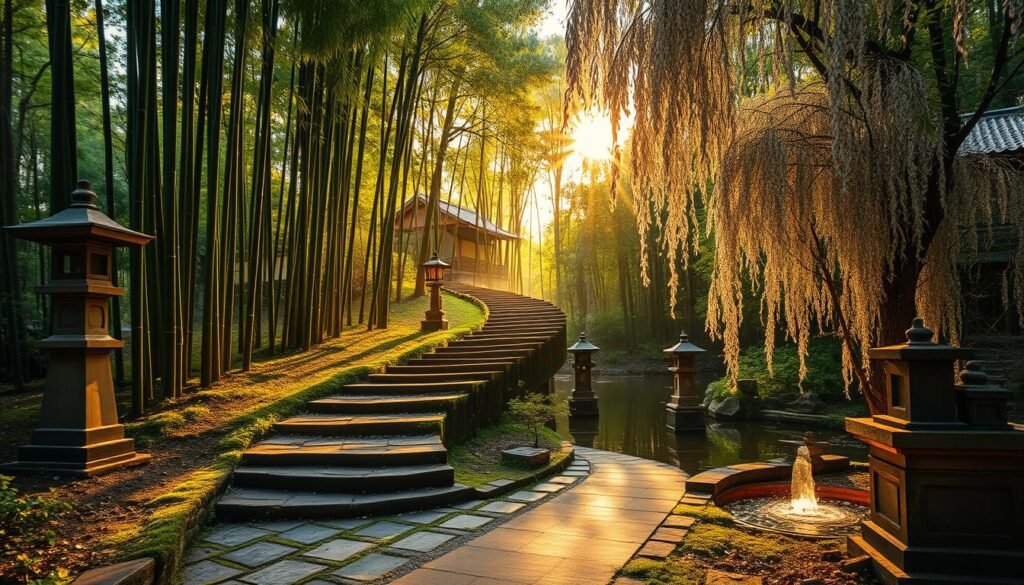
A gentle 2 km stroll along a shaded canal is my favorite reset between two major temples. I start near Nanzen-ji and follow the route north, letting the steady flow slow my pace.
I often dip into small sites like Honen-in for moss gardens that most visitors miss when rushing. The area feels quiet and private, especially in spring when cherry blossoms arch over the water.
I plan this stretch as the peaceful middle of my city day. I pack a light snack and water because cafés are spaced out along the residential lanes.
Wear comfortable shoes—the path is level but long enough that you’ll notice by the time you reach Ginkaku-ji. I keep my camera ready for reflections and tiny shrines tucked among trees and stone.
| Feature | Detail | Best season |
|---|---|---|
| Length | ~2 km pedestrian canal route | Spring (blossom) / Fall (gold light) |
| Start / End | Nanzen-ji → Ginkaku-ji | Plan half a morning for a relaxed pace |
| Access | Nearest station: Keage (Tozai), ~15 min walk | Less crowded on weekdays |
- I treat the route as an unhurried walk that bridges major temples without transit.
- I browse small artisan shops just off the path for ceramics and prints.
- When crowds thicken near Ginkaku-ji, I know my time along the canal has come to a close.
Nanzen-ji Zen Complex: Grand Gates, Aqueduct Arches, and Quiet Subtemples
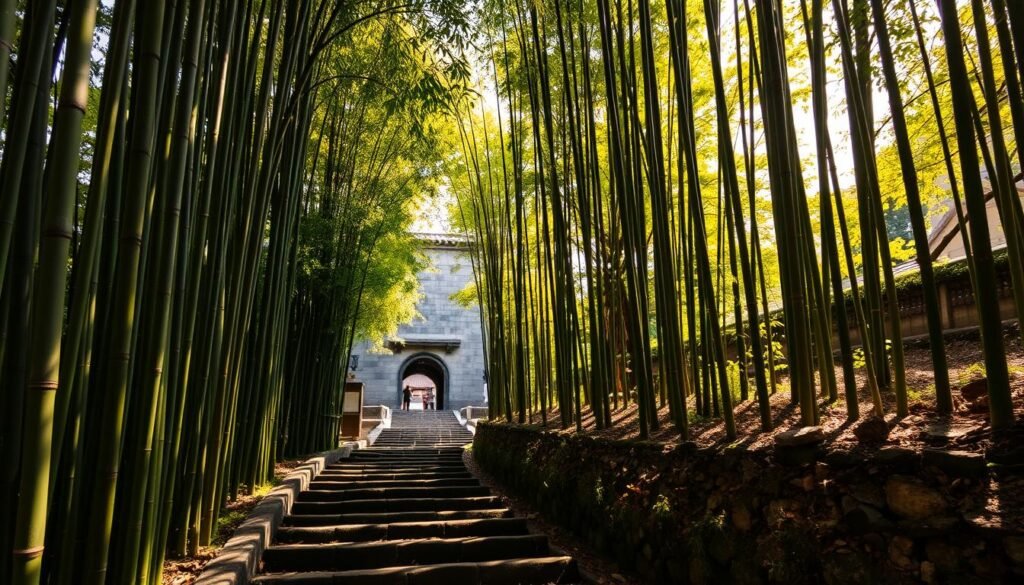
Morning light turns the aqueduct arches at Nanzen-ji into an unexpected corridor between eras. I wander the free grounds first, pausing under the massive Sanmon gate to feel how the place mixes temple scale and Meiji engineering.
Why I time Tenjuan early. I arrive just after opening so the rock garden and pond garden feel private. The moss pops in soft light, and a small bamboo grove catches a warm glow later in the day.
I reach the complex by subway to Keage Station (Tozai Line) and walk leafy lanes straight into the area. When I crave more nature, I add a short climb to Oku-no-in beside a little waterfall.
Practical notes
- Tenjuan: 500 yen, open 9:00–16:45.
- I treat Nanzen-ji as a gateway to the Philosopher’s Path for a longer, slow stroll.
- I keep my voice low and move slowly along the engawa to respect the calm.
| Feature | Detail | Best time |
|---|---|---|
| Sanmon & grounds | Free access | Morning |
| Tenjuan | Rock & pond garden, bamboo | After opening / late-afternoon |
| Access | Keage Station (Tozai) | Short walk |
“Tenjuan often feels like a quiet reset button for my day.”
Ginkaku-ji (Silver Pavilion): Sand Gardens, Mossy Paths, and City Vistas

Morning quiet makes Ginkaku-ji feel like a private study of light and texture. I enter at opening and give myself time to absorb the precise white sand garden and the still pond before crowds arrive.
I follow the one-way loop up the hillside for wide views of the pavilion framed by maples and pines. The mossy paths ask me to slow my pace; the shades of green and stone basins reward patient eyes.
The fee is 500 yen and usual hours run 8:30 am–5 pm (winter shorter). I often slot this visit after the Philosopher’s Path or as a late-afternoon wind-down.things-to-do-in-kansas-city
I watch seasonal shifts closely: spring greens, deep summer shade, warm fall tones. I move with the flow along the route, stepping aside for photos and capturing raked sand patterns and small details.
- I pair the stop with a nearby snack street to refuel before heading back toward the city.
- I keep expectations grounded—there’s no silver leaf here, only an elegance in understatement.
For practical information and a quick overview of Ginkaku-ji details, I link a concise guide that helps me plan my time and route: Ginkaku-ji details.
Kinkaku-ji (Golden Pavilion): A Shimmering Icon Worth Timing Right
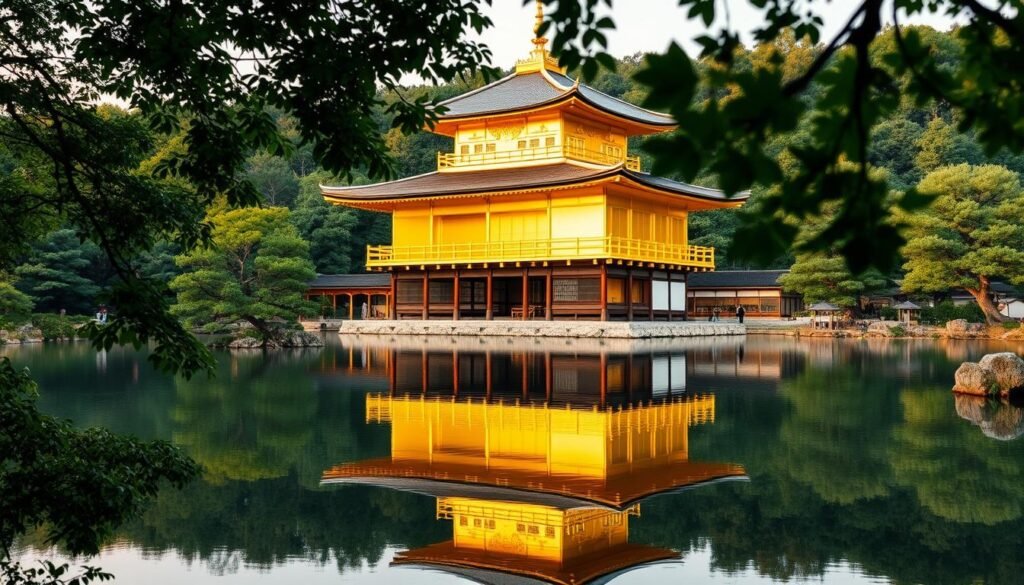
I time my visit so the Golden Pavilion sits quiet and mirrored before crowds gather.
Why I go early: entry opens at 9:00 and the fee is 500 yen, so arriving right at opening often means a calm pond reflection and fewer tourists. The pavilion’s top floors are covered in gold leaf and viewable only from across the water; there is no interior access.
The shrine grounds form a one-way path through a compact garden. The route is short but memorable, so I accept that the visit will be brief yet impactful.
I usually pair this attraction with another northwest stop or plan Arashiyama later. If I’m short on time, I take a taxi; if I want a slower morning, I ride a bus or bike.
I watch for seasonal frames—autumn maples or winter snow make the gold pop. I keep the way clear for others and step back after a few clean shots.
- Tickets: 500 yen, 9:00–17:00.
- Best move: arrive at opening for calmer views.
- Tip: stop at the teahouse if the line is short; otherwise walk the garden and move on.
| Feature | Detail | Best time |
|---|---|---|
| Entry | 9:00–17:00 / 500 yen | Opening hour |
| View | Across pond; no interior access | Early morning reflection |
| Access | Bus, taxi, bike; small garden path | Pair with northwest stops |
| Visitor note | Often crowded; short visit | Arrive early and be patient |
“An early start transforms a crowded landmark into a quiet, reflective moment.”
Arashiyama in a Day: Beyond the Crowds to Gardens, Hillsides, and River Walks
I build my Arashiyama day around gardens, hillside views, and long river walks that clear my head. This area rewards a slow pace and a handful of focused stops rather than racing through every sight.
Tenryu-ji’s garden pause
I start at Tenryu-ji and settle by the pond. The UNESCO garden frames the Arashiyama mountains and gives me a quiet moment before crowds arrive.best-places-to-visit-in-california
Quiet hillside temples
I follow shaded lanes up to Jojakko-ji (500 yen, 9:00–17:00) for mossy roots and calm views. Then I head farther for Otagi Nenbutsu-ji (400 yen, 9:00–16:30) and its 1,200 playful rakan statues.
River calm and practical moves
I ride the JR train to Saga-Arashiyama Station and plan short walks between stops. When people swell, the Hozugawa bank becomes my reset; watching boats and the river eases the flow.
- I keep the famous bamboo moment flexible—early or as a detour.
- I avoid a car and favor the train and short walks for a relaxed day.
- Lunch near Tenryu-ji or the river keeps the pace simple.
| Place | Fee | Hours |
|---|---|---|
| Tenryu-ji | Varies | Garden hours |
| Jojakko-ji | 500 yen | 9:00–17:00 |
| Otagi Nenbutsu-ji | 400 yen | 9:00–16:30 |
“I end the day with a slow look across the Katsura, grateful that a well-planned day here still feels easy.”
Arashiyama Bamboo Grove: If I Go, This Is How I Make It Enjoyable
I save the bamboo grove for an early, quick visit so the light and silence feel like a private show. The main path is short—about 500 m—and it fills fast after sunrise.
My rule: arrive before first light. Within 20–30 minutes the corridor crowds and clear photos vanish.
I move straight to the quietest stretch, then backtrack for any shots I missed. I carry minimal gear so I can pass through quickly and catch canopy frames when the lower path is busy.
Practical moves I use
- I pair the grove with the Sagano Romantic Train later, since the train starts about 9 am.
- I respect the grove: stay on the path and never touch stalks; that keeps this place healthy.
- If the area is packed, I pivot to Tenryu-ji garden or the river and try bamboo another morning.
“The best visits are short: arrive early, move with purpose, and enjoy the calm while it lasts.”
Nishiki Market: My Midday Food Crawl and Favorite Finds
I treat Nishiki as my midday lab for quick bites, bright flavors, and small souvenirs.
The covered arcade runs five blocks and hosts more than 100 vendors. I arrive around 10 am or just before closing near 5 pm to avoid peak lunch lines. That way I can snack, shop, and move without elbow-to-elbow crowds.
I taste skewers, seasonal sweets, and small fish plates between stops at pottery and knife shops. I keep cash ready and pace myself so I have room for multiple samples.
When I want a sit-down, I slip onto a parallel street after a quick stretch of the arcade. I use a nearby station and a short train ride for the fastest approach. I ask vendors what’s fresh and step aside while I eat so other shoppers flow by.
What I taste, from fresh bites to sweet treats and pottery stops
- Snacks: skewers, grilled fish, tempura samples.
- Sweets: seasonal mochi and candied fruits.
- Gear: knives, cookware, and handmade pottery shops between stands.
- Practical: bring cash, pick 2 must-try stalls, and map your next stop before you leave.
| Feature | Detail | Best time |
|---|---|---|
| Length | Five covered blocks, 100+ vendors | Late morning or just before 5 pm |
| Main finds | Street snacks, sweets, knives, pottery, cookware | Sample as you stroll |
| Access | Nearby station; short train ride from central hubs | Arrive early to avoid crowds |
“I love how the arcade anchors the middle of my day—perfect between early temples and an evening walk.”
Pontocho Alley and Shirakawa-dori: Where I Love Kyoto After Dark
I love to wander Pontocho after dark, feeling narrow lantern-lit counters and old-school bars fold around me. The alley is car-free and small restaurants often lack English menus, so I research a couple spots ahead and then let the night lead.best-places-to-visit-in-may
I drift next toward Shirakawa-dori for a slow canal-side walk. Lanterns reflect on the water and the city fades to whispers. Fall leaves over the canal heighten the mood.
I watch etiquette closely: keep voices low, give space at counters, and pick simpler menus when language is limited. I order tea or sake and a few small plates rather than a heavy meal.
- I map a safe, direct way back to my stay before I linger.
- I sometimes pause at Yasaka Shrine for a quiet moment under glowing lanterns.
- This area becomes my favorite night ritual: walk, eat, sip, repeat.
| Spot | Vibe | Best time |
|---|---|---|
| Pontocho Alley | Narrow counters, old bars, low light | Evening—after sunset |
| Shirakawa-dori | Riverside, lantern reflections | Night walk—especially fall |
| Yasaka Shrine | Quiet lanterned shrine | Late night for calm |
Tea Ceremony in Gion: Slowing Down With Matcha
I often book a short lesson in a tucked-away teahouse, turning a busy schedule into a calm pause. A one-hour visit in Gion is a compact way to learn the basics of matcha and the quiet rules that shape the ritual.
Shorter experiences I book and what I learn each time
I choose a one-hour ceremony so I can sit on tatami, taste a seasonal sweet, and try whisking matcha myself. The host shows tools, water temperature, and whisk technique, then guides my hands.
I treat this hour as a reset between morning sights and evening plans. The place I pick welcomes beginners and focuses on cultural context and warm hospitality.
- I follow small gestures and cues; the gentle etiquette is part of the lesson.
- No rush, no photos unless invited—attention is the point.
- I leave with a clear sense that the ceremony is as much about presence as flavor.
“A short ceremony in Gion gives me a meaningful hour without claiming my whole afternoon.”
Side Trip Note: Why I Pair Kyoto With Nara’s Tōdai-ji on Longer Stays
For a quiet contrast, I reserve a morning for Nara’s great hall and the friendly deer that roam its park.
Tōdai-ji is one of the country’s most significant temples, famous for the Daibutsuden and its giant Buddha. I allow about an hour for the main hall, then spend more time wandering the park and greeting bowing deer.
I take an easy train from Kyoto and use simple station connections, which keeps the trip low-stress. I aim for a mid-morning arrival to miss heavy tour group pulses.
- I budget the fee (roughly 600 yen) and pack light with comfortable shoes for a relaxed park loop.
- I grab a simple lunch near the park, watch the weather, and keep the day calm with fewer stops.
- The attraction’s scale complements city temples and makes a great day extension.
| Feature | Detail | Best time |
|---|---|---|
| Entry | About 600 yen | Mid-morning |
| Visit length | ~1 hour at Daibutsuden; extra for park time | 2–4 hours for a relaxed loop |
| Access | Direct train; short walk from station | Mid-morning arrival recommended |
“A calm side trip to Nara expands the day without rushing the travel rhythm.”
Getting Around Kyoto: Trains, Walks, and When I’d Consider a Car
I plan each day around a compact route so transit becomes a quiet part of the trip. That habit keeps travel simple and gives me more time for narrow streets, gardens, and markets.
My route choices from Kyoto Station to major attractions
I map a single line from Kyoto Station and build the morning around it. That puts logistics on autopilot and reduces wasted time.
- Fushimi Inari: JR Nara Line from Kyoto Station to Inari Station ~5 minutes; Keihan from Gion-Shijo is about 10 minutes.
- Arashiyama: JR San-In Line to Saga-Arashiyama ~17 minutes, or the Randen tram for a relaxed ride.
- Nanzen-ji: Keage Station (Tozai Line), then a walk along the Philosopher’s Path to Ginkaku-ji.
Pros and cons of renting a car vs public transit and taxis
Why I usually skip a car: trains and walking cover central sights efficiently. Parking exists but finding a spot near temples can cost time and stress.
When I’ll choose a car: long day trips outside the city or moving luggage between distant hotels. A car helps with remote schedules, but I park early and plan routes carefully.
Taxis and IC cards: I use taxis when I’m short on time or linking poor connections. I keep an IC card and small change ready so train entries and exits are seamless.
| Move | Typical route | Best use |
|---|---|---|
| Short hop | Kyoto Station → Inari (JR) ~5 min | Early-morning shrine visits |
| West day | Kyoto Station → Saga-Arashiyama (JR) ~17 min | Arashiyama gardens & river |
| Scenic link | Keage Station (Tozai) → walk Philosopher’s Path | Combine Nanzen-ji and Ginkaku-ji |
| When a car helps | Rental with planned parking | Wide day trips or heavy luggage |
“Map the first stop from Kyoto Station and let that decision shape your day—logistics then fade into the background.”
Conclusion
In closing, smart timing often turns crowded spots into private memories.
I wrap this short guide with a simple plan: pick one or two headline stops each day and let markets, riverside lanes, and a quiet subtemple fill the rest. When you visit kyoto, favor sunrise or night for marquee moments—especially at fushimi inari.
Weave a short tea ceremony into your schedule and give yourself the chance to wander Gion and pause by the river. Fall and spring lift the color, but smart timing keeps crowds from defining your trip.
Use this list as a flexible map. Tailor it to weather, mood, and the city you meet, and you’ll end each day with a quiet, grateful end.






